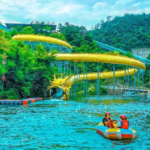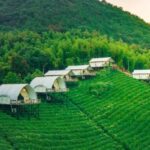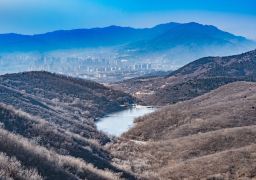Yunqi Temple, established by the Tiger-Subduing Zen Master in the 5th year of the Qiande era during the Northern Song Dynasty, is a renowned temple of the Fayan sect. In the 5th year of the Longqing era during the Ming Dynasty, Master Rong Hong, witnessing the temple’s decay, undertook its restoration, setting up meditation rooms and advocating the unity of the three teachings and the integration of Zen and Pure Land Buddhism, which earned him the reverence of both monks and laypeople. The temple gradually regained its former glory and was known as the ‘Yunqi School,’ becoming one of the five major temples in Hangzhou, alongside Lingyin, Jingshui, Huqiao, and Zhaoqing temples. Although the Buddhist temple no longer exists today, its charm and ancient ambiance remain. It is said that colorful clouds often linger over Wuyun Mountain, hence the name Yunqi, which was established by the Wu Yue Kingdom in the 5th year of Qiande. In the third year of Zhiping, it was renamed Qizhen Hall, and in the fifth year of Longqing, the old name Yunqi was restored. In the 38th year of the Kangxi era of the Qing Dynasty, Emperor Kangxi inscribed ‘Yunqi’ and ‘Pine Clouds’ on two tablets. In the 16th year of the Qianlong era, Emperor Qianlong inscribed ‘Fragrant Door Pure Land,’ ‘Pleasant Nature Pavilion,’ and ‘Deep Bamboo Groves’ on three tablets, and in the 27th year, he inscribed ‘The Western Paradise of Ultimate Bliss and Nurturing Dao Field’ on another tablet. The original temple walls bore Qianlong’s poetic inscriptions and Dong Qichang’s calligraphy of the ‘Diamond Sutra’ on stone tablets. Surrounded by lush bamboo and winding stone paths stretching for several miles, the temple area was known as ‘The First Mysterious Zone of Lakes and Mountains.’ Li E, who visited Yunqi, composed the poem ‘Staying at Yunqi Temple.’ In the 1960s, some of Yunqi Temple’s halls were converted into the Hangzhou Federation of Trade Unions’ rest and recuperation center. The two buildings in front of the temple were renovated into ‘Chongyun Tower’ and ‘Shuhuang Pavilion,’ and a ‘Douyun Pavilion’ was built at the foot of the stone steps leading to Wuyun Mountain. The temple’s opening hours and business status are subject to the daily opening conditions.
Yunqi Temple
Yunqi Temple, established by the Tiger-Subduing Zen Master in the 5th year of the Qiande era during [...]









